Looking for simple doodle mandala art ideas? Try starting with a circle mandala topped with dots and lines, or fill notebook corners with half-mandala patterns. Flower petal mandalas burst with flowery vibes, while geometric shape designs keep things extra tidy. Immerse yourself in black-and-white minimalist looks, or get wild with swirl and loop creations. Mandala borders make sketchbooks pop, and layered wave patterns mesmerize anyone who looks. Even nature-inspired mandalas keep things fresh and fun. Curious for more awesome ideas?
Key Takeaways
- Start with a basic circle and add dots, lines, and simple shapes radiating outward for a classic mandala look.
- Experiment with geometric shapes like triangles and squares to create symmetric, visually appealing patterns.
- Use flower petal designs by drawing layers of similarly sized petals around a central point for a beginner-friendly mandala.
- Incorporate repeating zigzags, loops, or swirl patterns to add dynamic energy and creative flair.
- Decorate sketchbook page borders with mandala-inspired repeating shapes and patterns for a simple, decorative frame.
Circle Mandala With Dots and Lines
Imagine a blank sheet of paper—kind of boring, right?
Now, picture turning it into something awesome by drawing a circle mandala with dots and lines. Artists usually start with a central point, then use a compass to get those perfect circles (straight lines are for amateurs).
The real fun happens when they play around with dot spacing—close together for detail, wide apart for a cool, airy vibe. Lines connect the dots, and the line thickness changes everything; skinny lines look delicate, while thick lines make the design pop.
Each mandala looks different, depending on how the artist mixes and matches these things. Grab pens or pencils (nothing fancy needed), and even try it out digitally.
Suddenly, that boring paper? Total masterpiece potential.
Flower Petal Mandala Designs
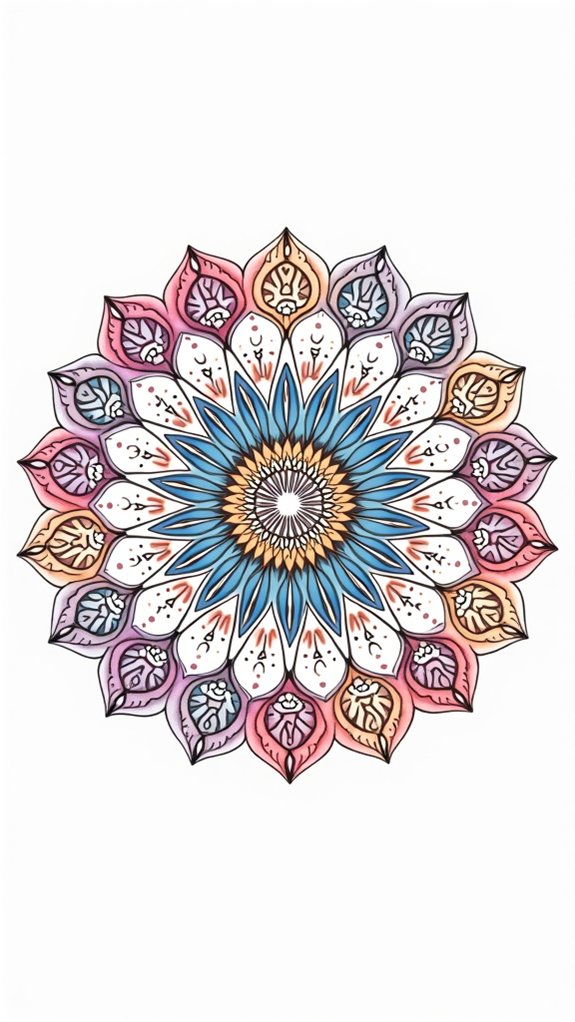
Flower petal mandala designs are a blast to create, especially when you start from the center and build outwards with step-by-step petal patterns.
By adding one layer at a time—maybe skinny petals first, then big bold ones—you can make the whole thing look way more complex (and impress anyone peeking over your shoulder).
Mixing up the sizes and stacking layers almost feels like giving your drawing a superpower, turning a simple doodle into something that totally pops off the page.
Step-by-step Petal Patterns
A petal mandala brings together symmetry, creativity, and just a bit of “wow!” Starting with a plain circle smack in the middle of the page, the whole design blooms outward—sort of like the coolest math-meets-art experiment ever.
For perfect petal symmetry, the key is to keep those petals the same size and spaced out like pizza slices. Using a ruler or compass? Smart move—it’s like a shortcut to mandala balance.
Play around with different petal shapes—teardrops, ovals, skinny, chubby—no wrong answers here! Each petal gets its own space to shine.
And don’t be shy; adding lines, dots, or tiny shapes inside your petals turns each one into a little world of detail. Before you know it, your flower bursts into mandala magic!
Enhancing Designs With Layers
Stacking one layer of petals on top of another cranks up the “wow” factor in mandala art faster than you can say “petal power.”
Instead of letting the design sit flat, layering petals gives the whole mandala a pumped-up, 3D look—like it’s basically bursting off the page. Using smart layering techniques, artists start with a simple flower in the center, then add rings of petals, each with unique sizes and shapes.
Mixing in petal variations—like switching between rounded and pointy shapes—brings crazy cool personality. Throw in contrasting colors or patterns for each layer, and it’s a total eye-catcher.
Tools like compasses and rulers help keep things neat and even. Don’t be afraid to experiment, because that’s what makes every mandala art piece pop!
Half Mandala Corner Patterns
Drawing half mandala corner patterns is super satisfying, especially when you start with easy half-circle designs that look amazing even with basic shapes.
Getting your composition right in the corner takes a bit of practice—sometimes it feels like playing Tetris with curves and patterns, but the challenge keeps things interesting.
It’s also fun trying to balance all the lines and empty space, making sure your doodle pops without looking too crowded or too lonely.
Easy Half Circle Designs
Even though mandala art might look super fancy, half circle designs—especially those tucked into corners—totally believe in keeping things simple and fun.
They’re awesome for anyone who wants to try out beginner techniques without feeling lost in a maze of complicated swirls and dots. Symmetry rules here, and clean, bold lines make these half-circle creations look sharp—even if you didn’t pass geometry!
By repeating small shapes, like dots or tiny petals, and sprinkling in creative variations with colors, anyone can transform a doodle into an eye-catching corner masterpiece. Seriously, it’s way easier than trying to draw a perfect circle blindfolded!
- Use a ruler or compass to keep curves super smooth
- Experiment with easy lines and shapes for beginner techniques
- Fill spaces with repeating dots or petal patterns
- Try wild, creative variations with bright colors
Corner Composition Tips
Ever wonder how to turn an empty corner of your page into a total showstopper? Imagine this: a half mandala design bursting from the edge, perfectly balanced with corner symmetry and some seriously smooth design flow!
To nail this look, artists start by marking a central point in the corner. Grab a compass for those crisp circles—no more lopsided disasters!
Let the shapes bloom outward: petals, leaves, funky geometric bits—anything that makes your pattern pop. Repeat elements to give your mandala that pro, harmonious vibe.
Don’t be afraid to go bold with contrasting colors or handy shading tricks; they’ll make each mandala section jump out without looking weird next to the rest.
It’s all about transforming blank corners into pure magic!
Balancing Patterns and Space
While half mandala corner patterns may look super fancy at first glance, finding the right balance between detailed patterns and empty space is where the real magic happens.
It’s easy to get carried away with the tiny lines and dots, but creative spacing keeps the design from feeling too crowded. Pattern symmetry makes these corner motifs feel super satisfying, and it’s not just for expert artists—beginners love it too!
Tools like rulers and compasses help keep the mandala shapes precise, but there’s still so much room for fun and experimentation. Adding pops of color can make your patterns even more eye-catching, giving each design its own personality.
- Try mixing simple and detailed shapes
- Leave blank spaces for dramatic effect
- Use different sizes for interest
- Keep pattern symmetry in mind
Geometric Shape Mandalas
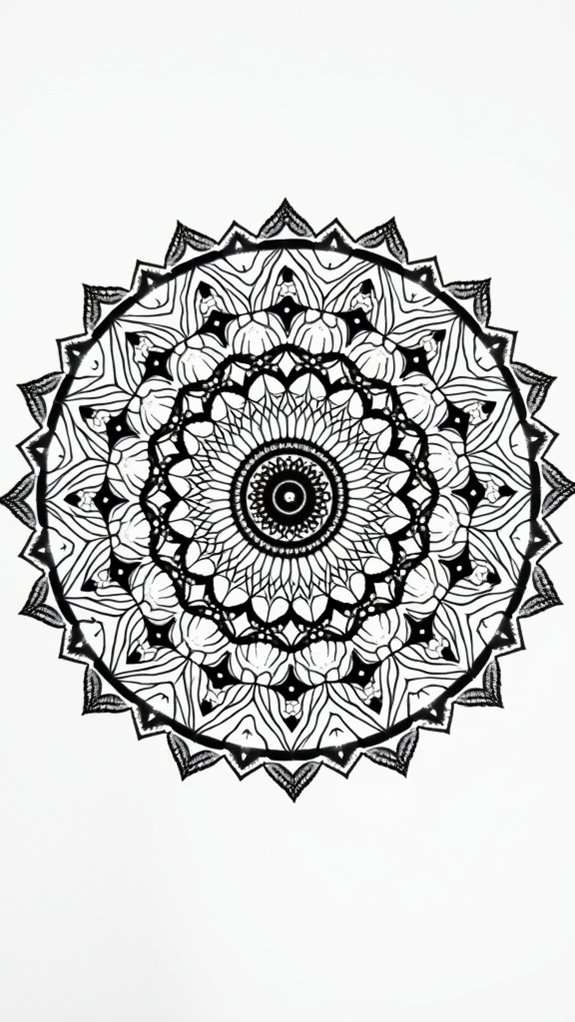
If drawing a perfect circle with just a pencil makes someone feel like a wizard, then creating geometric shape mandalas is basically casting an art spell. These designs start simple—think circles, triangles, squares, and hexagons.
But with a bit of geometric exploration, suddenly those basic shapes turn into dazzling patterns. It’s like building an epic puzzle with endless possibilities. Artists don’t just doodle randomly—they use tools like compasses and rulers for next-level symmetry practice and precision.
The real magic? Playing with colors inside each repeated shape, making the whole mandala pop with energy and personality.
Whether a beginner or already a mandala master, anyone can experiment with these shapes and create artwork that looks perfectly balanced, seriously cool, and, let’s be honest, pretty much enchanted.
Black and White Minimalist Mandala
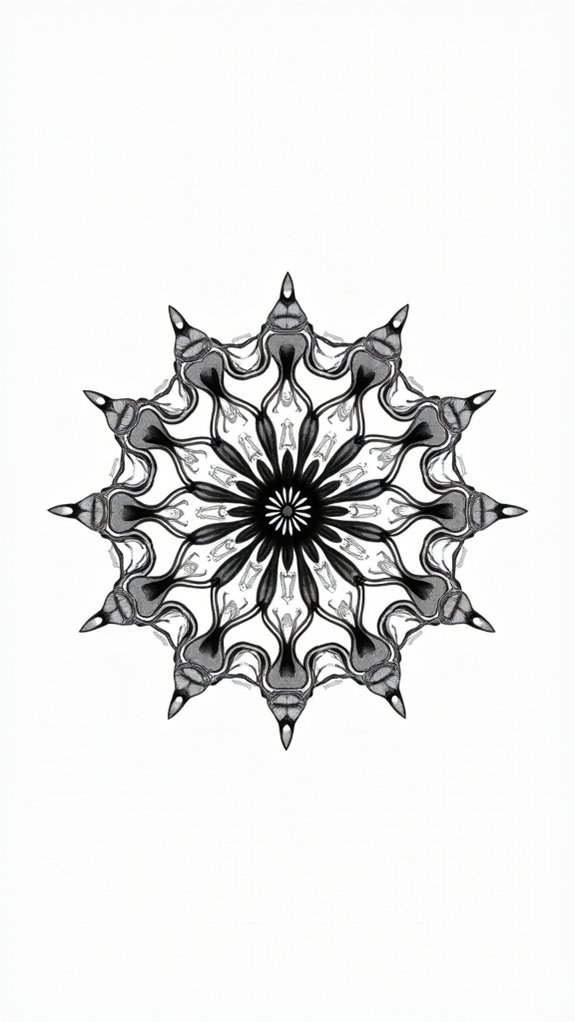
Although it might sound simple, black and white minimalist mandalas pack a surprising punch. Just two colors—okay, technically one color plus the paper—can create seriously dramatic art.
These mandalas focus on crisp line detailing and pattern symmetry, making the whole thing feel way fancier than you’d guess. Simple tools like pens and blank paper become your ticket to a soothing, almost meditative doodle session.
Plus, because there’s no color to distract you, every swirl and shape stands out. Need some ideas? Check these out:
- Draw basic circles and add repeating triangles for bold, graphic energy.
- Use zigzags and dots to create mesmerizing line detailing.
- Try patterns that radiate from the center for perfect pattern symmetry.
- Share your finished black and white mandala on social media for instant bragging rights!
Starburst Doodle Mandala
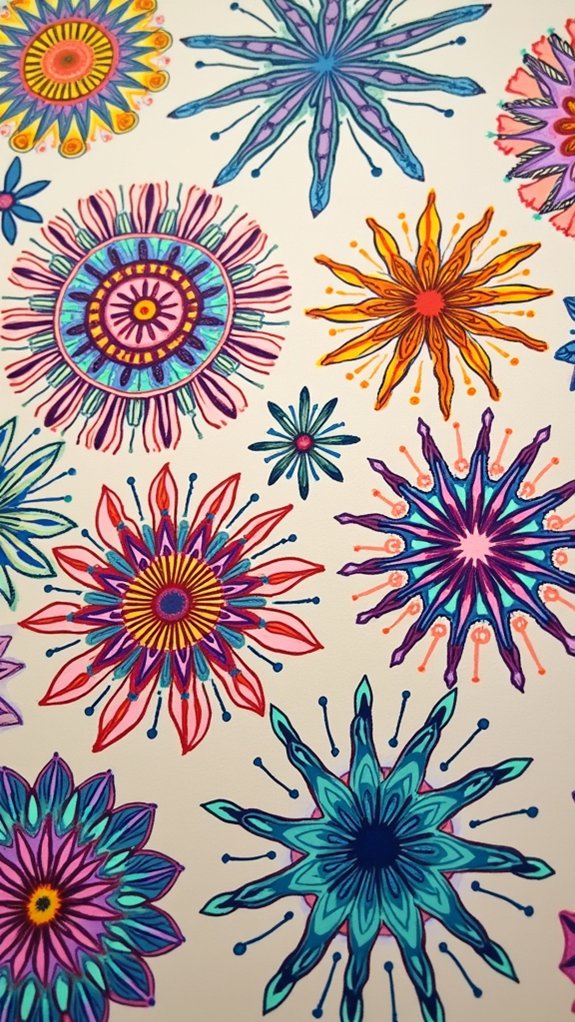
Energy practically bursts off the page with a starburst doodle mandala. These mandalas seem like fireworks frozen in time, all thanks to radiating lines and patterns shooting out from a bold center.
Artists love to mix up starburst variations, from super-simple thunderbolt shapes to wild, super-detailed zigzags and swirls. Starburst mandalas are a playground for experimenting with color combinations—try massive energy with bright oranges and yellows, or go cosmic with blues, purples, and a dash of neon.
Mix thick and thin lines to pump up the drama, or add buh-zillion tiny patterns for hypnotic detail. With a little practice, anyone can master symmetry and pattern-making, all while feeling like they’re doodling a burst of pure energy.
Mandala Borders for Sketchbooks
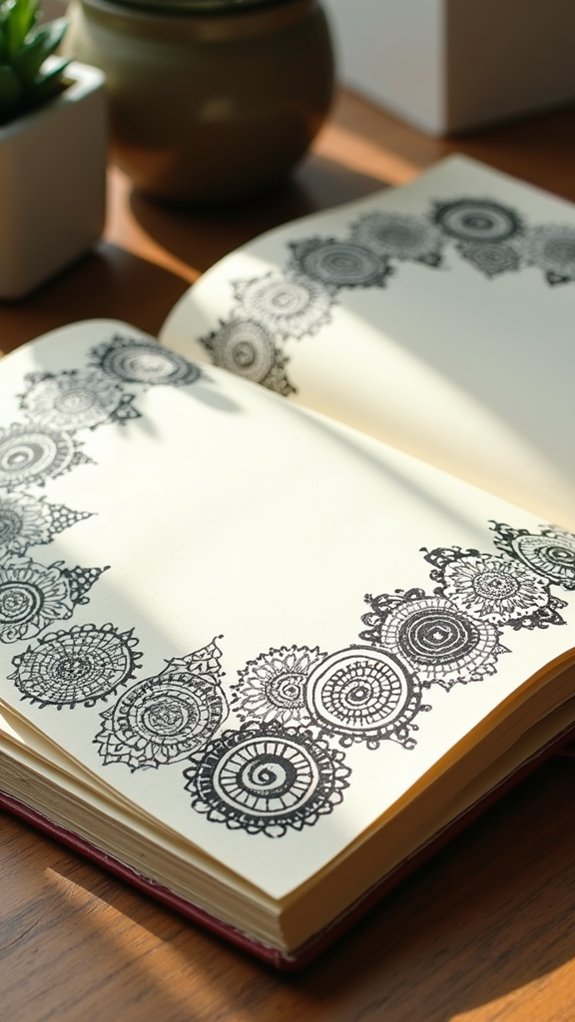
Mandala borders for sketchbooks are like fancy picture frames, only way more fun to create, and they instantly make any page pop.
Playing around with repeating patterns, mixing up shapes, or even sneaking in a surprise doodle here and there, can turn a plain page edge into a real showstopper.
With just a pen and a little imagination, anyone can turn their sketchbook into a work of art that’s full of personality—no magic required, just a bit of pattern power!
Repeating Pattern Techniques
Plenty of artistic magic happens when repeating patterns crawl along the borders of a sketchbook page, turning plain edges into something eye-catching and dynamic.
With every loop and line, pattern symmetry and design balance bring order to the wild world of doodling. Using repeating shapes—think circles, triangles, or petals—offers a quick way to spice up those borders while still keeping everything neat.
Don’t be shy about grabbing a ruler or compass to make your designs look sharp and professional—nobody needs to know if you can’t draw a straight line!
Want to kick up the fun? Mix up the sizes, shuffle different line styles, and add some color for a real wow-factor.
- Repeat simple shapes for unity
- Use rulers or compasses for neatness
- Vary line styles and sizes
- Stick to a color palette for harmony
Border Design Inspirations
Just when it seems like repeating patterns have everything under control, borders burst onto the scene and steal the show.
Mandala borders are like cool frames for sketchbook pages, lifting the whole vibe with their intricate style. Want border symmetry? Grab a ruler or compass—those helpers make lines crisp, and shapes even, no matter how wild the pattern gets.
Simple doodle borders with wave designs, geometric shapes, or leafy vines give endless options, and there’s no rule against adding a bold splash of mandala color. Experiment with shading, or go wild with bright hues to show off your creative side.
Online tutorials, like “Simple Circle Mandala -1,” can help beginners start strong. Who knew borders could be this much fun?
Enhancing Page Visuals
Envision this: a sketchbook page looks kind of empty, but all it really needs is a snazzy border to take it from “meh” to “wow.”
Borders aren’t just there to keep your drawings from falling off the page—they actually boost the whole look, acting like a spotlight for your art. Mandala borders work wonders, giving your sketches a cool, finished frame while showing off funky mandala color choices and flawless border symmetry.
Draw a few lines, drop in some repeating shapes or flowery doodles, and suddenly each page pops! Experimenting with these borders can be super relaxing, too—almost like art meditation (except no one is snoring).
Want to level up your pages? Try these friendly ideas:
- Mix mandala color palettes
- Play with border symmetry
- Switch up line thickness
- Test floral and geometric repeats
Layered Wave Pattern Mandala
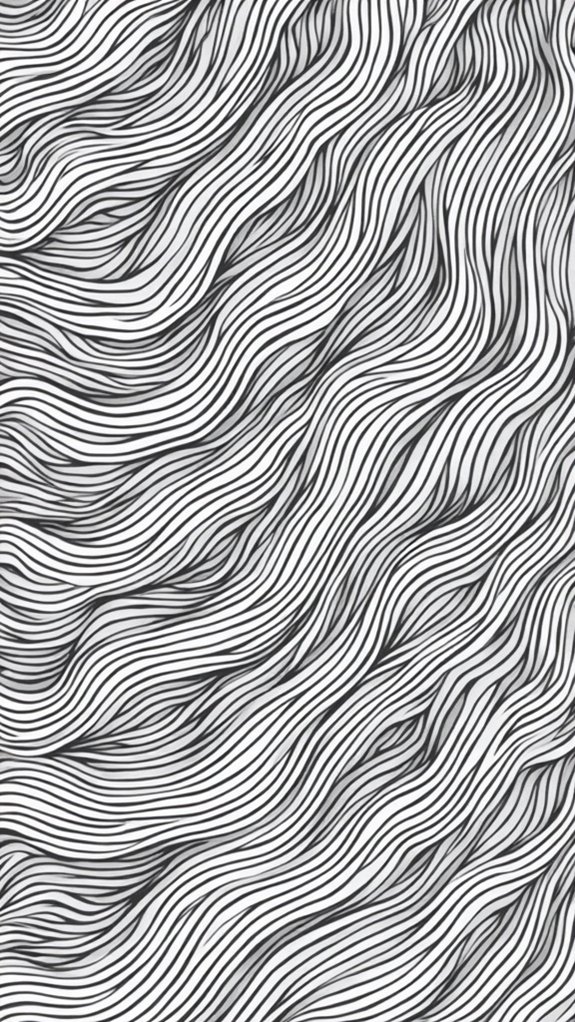
Waves of creativity crash onto the page with the layered wave pattern mandala, a design that’s as mesmerizing as it sounds. This mandala is like a ripple in a pond—once the first circle drops in, the wave motion spreads out into gorgeous, concentric layers.
Starting at the center, artists use curved lines that gently flow outward, each line mimicking another tiny wave joining the fun. It’s a rhythm that’s almost hypnotic!
Keeping those layers symmetrical calls for a cool tool combo: compass and ruler—seriously, they’re your best friends here.
To dial up the wow factor, adding different colors in each layer transforms the mandala into an eye-catching masterpiece. Whether you’re a newbie or a doodling legend, this pattern is pure, splashy perfection.
Swirl and Loop Mandala Creations
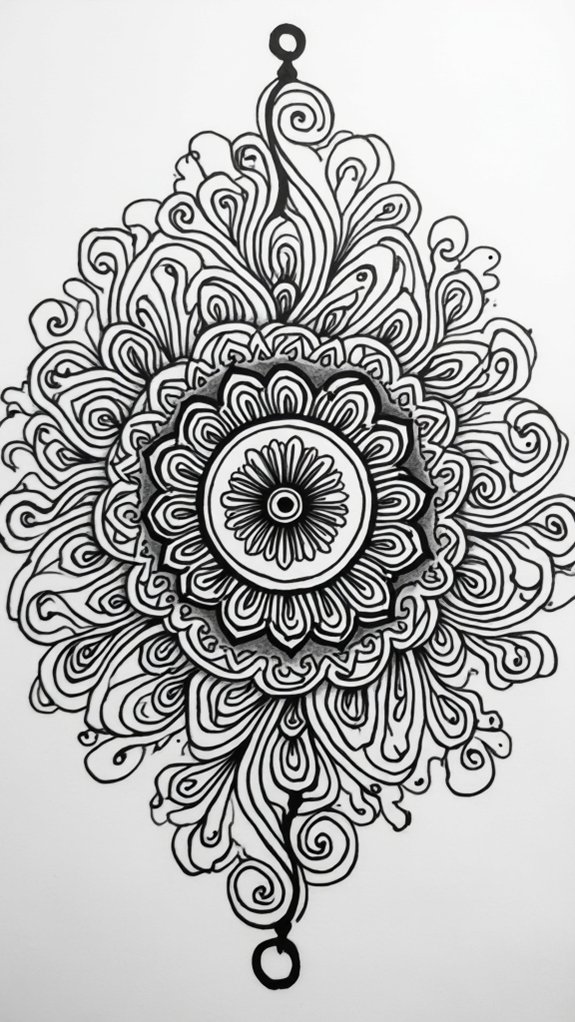
After riding the layered wave pattern, it’s time to crank up the motion with swirl and loop mandala creations.
Imagine this: lines that whirl around, loops that spin, and patterns that seem to dance right off the page! Swirl techniques bring loads of energy, while loop variations add that touch of wild creativity—no two designs will ever look the same.
Want tips to make your art pop? Grab your compass, and let’s get swirling! Here’s what to keep in mind:
- Begin every swirl mandala with a central point, then spiral out for maximum motion.
- Mix up loop sizes and leave different spaces for fun, punchy effects.
- Use color gradients to highlight the movement.
- A compass keeps curves looking smooth and totally pro!
Simple Nature-Inspired Mandalas
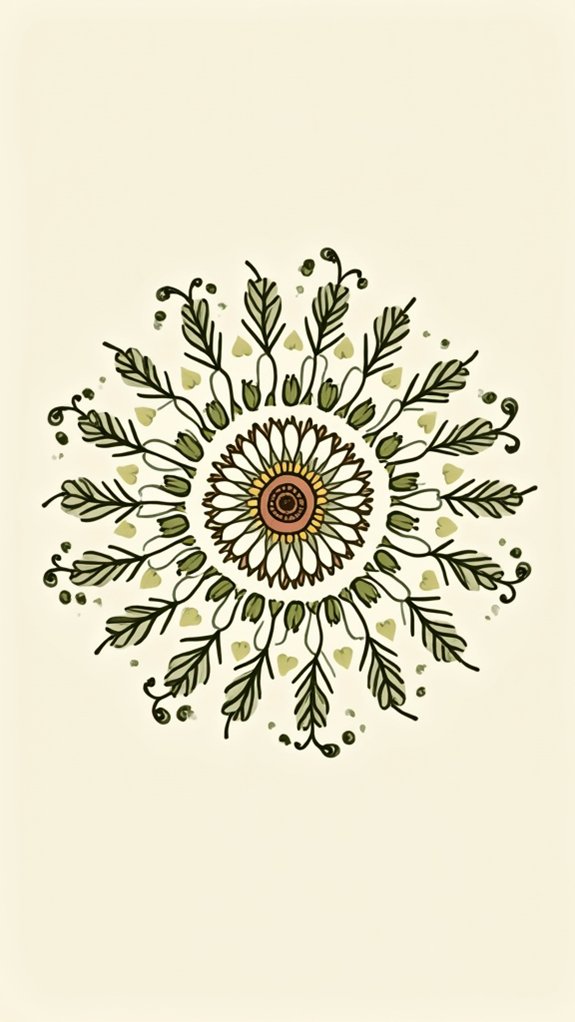
Leaves, flowers, and sunshine—there’s just something magical about turning bits of nature into beautiful mandala patterns!
Imagine drawing swirling leafy designs, or delicate floral motifs, all spinning in perfect circles like a secret garden on your sketchbook page. Using simple shapes like circles, petals, or even sunbursts, anyone can create nature-inspired mandalas that totally capture the beauty of the outdoors.
Want your art to pop? Grab some colors and make those leaves extra green, or the petals super bright. Tools like compasses and rulers come in handy for keeping every line smooth and balanced, but hey, wobbly lines add character, too!
For a personal touch, try adding your favorite flowers or plants—maybe even a squirrel or two hiding in the pattern!
Frequently Asked Questions
How to Draw Mandala Art Very Very Easy?
The current question asks about drawing mandala art in a very easy way. Using simple techniques, one can start with basic shapes like circles and petals, then repeat patterns and gradually add detail, keeping the process accessible.
What Is the Rule for Creating Mandalas?
When creating mandalas, artists follow the rule of establishing symmetrical patterns radiating from a central point. This method guarantees balance and harmony, reflecting the spiritual significance mandalas hold in various cultural and meditative traditions. Precision tools often assist.
What Is Mandala for Beginners?
For beginners, a mandala represents a structured, circular design rooted in mandala origins, symbolizing wholeness. Understanding mandala meanings, novices often start with basic patterns to explore creativity, relaxation, and mindfulness, while developing artistic and meditative skills.
What Are the Three Types of Mandalas?
The three types of mandalas include geometric patterns, natural forms, and abstract designs. Each type holds unique cultural significance, serving as creative inspirations, mindfulness tools, and symbolic representations within various traditions, appealing to different artistic and spiritual preferences.
Conclusion
Mandala doodling turns blank pages into mini masterpieces, even if your stick figures look worried for their lives. With just some circles, lines, or a burst of swirly patterns, anyone can create art that’s relaxing and cool to look at. Whether you stick to flowers, geometric shapes, or wild nature designs, the main thing is to have fun and keep trying. So grab a pen, trust your weirdest ideas, and let your creativity spiral out!


Leave a Reply